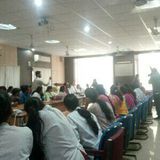
Top rated comment
over 7 years ago
But According to ayurveda we not to suppressed natural urge
over 7 years ago
You r right but 1 or the other day u will have to stop it.. Right?? And also if u go on coughing then it creates pressure on ur lungs which may be more troublesome...
Other commentsSign in to post comments. You don't have an account? Sign up now!
Related posts
Rheumatoid Arthritis: Causes, Signs, Symptoms, Diagnosis, Natural Ayurvedic Management (Amavata) (Indian system of medicine -oldest health science in the world then other health sciences/Ayurveda/5000 years old )
Rheumatoid arthritis (RA) is an autoimmune disease that causes chronic inflammation of the joints. Autoimmune diseases are illnesses that occur when the body’s tissues are mistakenly attacked by their own immune system.
Rheumatoid Arthritis Causes
The cause of rheumatoid arthritis is unknown. Even though infectious agents such as viruses, bacteria, and fungi have long been suspected, none has been proven as the cause. Certain genes have been identified though that increase the risk for rheumatoid arthritis.
Signs And Symptoms Of RA
Fatigue
Loss of energy
Lack of appetite
Low grade fever
Muscle and joint aches
Stiffness of joints, especially during morning hours (morning stiffness)
Also, during flares joints becomes warm, red and swollen. The small joints of both hands and wrists are usually involved.
How Is RA Diagnosed?
There is no singular test for diagnosing rheumatoid arthritis. The diagnosis is based on the clinical presentation. Ultimately, rheumatoid arthritis is diagnosed based on a combination of the presentation of the joints involved, characteristic joint swelling and stiffness in the morning, the presence of blood rheumatoid factor and citrulline antibody, as well as findings of rheumatoid nodules and radiographic changes (X-ray testing).
The American College of Rheumatology has developed a system for classifying rheumatoid arthritis that is primarily based upon the X-ray appearance of the joints. This system helps medical professionals classify the severity of your rheumatoid arthritis with respect to cartilage, ligaments, and bone.
Stage I
No damage seen on X-rays, although there may be signs of bone thinning
Stage II
On X-ray, evidence of bone thinning around a joint with or without slight bone damage
Slight cartilage damage possible
Joint mobility may be limited; no joint deformities observed
Atrophy of adjacent muscle
Abnormalities of soft tissue around joint are possible
Stage III
On X-ray, evidence of cartilage and bone damage and bone thinning around the joint
Joint deformity without permanent stiffening or fixation of the joint
Extensive muscle atrophy
Abnormalities of soft tissue around joint possible
Stage IV
On X-ray, evidence of cartilage and bone damage and osteoporosis around joint
Joint deformity with permanent fixation of the joint (referred to as ankylosis)
Extensive muscle atrophy
Abnormalities of soft tissue around joint possible
Rheumatologists also classify the functional status of people with rheumatoid arthritis as follows:
Class I: completely able to perform usual activities of daily living
Class II: able to perform usual self-care and work activities but limited in activities outside of work (such as playing sports, household chores)
Class III: able to perform usual self-care activities but limited in work and other activities
Class IV: limited in ability to perform usual self-care, work, and other activities
Management Of RA With Ayurveda
Modern science has no known cure for rheumatoid arthritis. The role of treatment in RA is to reduce joint inflammation and pain, maximize joint function and prevent joint destruction and deformity.
Physical therapy has no curative effect for arthritis nor does it alter the course of the disease process. The objectives of physical therapy are analgesia, maintenance of normal ranges of motion in involved joints, maintenance of normal power in muscles involved, protection of joints against additional trauma that might result in further structural deterioration / deformity.
Amavata: The Ayurvedic Correlation To Rheumatoid Arthritis
In Ayurveda, the clinical correlation of RA is Amavata. The following line of treatment is explained in the classical Ayurvedic texts for Amavata.
Langhana (Fasting)
Shodhana chikitsa (purification of the body)
Shamana chikitsa (treatment to reduce symptoms)
What treatments and therapies will an Ayurvedic practitioner advise? Hot fomentation can be done for the affected joints. Medicines for promoting the digestive fire, ama pachana, can be used. These include Amrithothoram kashayam, Rasna erandadi kashayam, Amritarishtam, Amritadi choornam and Amavatari rasa. Again, the medicines must be given after assessing the rogi and roga bala only.
Mridu virechana (mild purgation) can be given. Kshara vasti or Vaitarana vasti can be given. This is medicated, self-administered enema therapy. Upanaha can be done on affected joints.
RA Diet And Lifestyle Regimen
Avoid curd, fish, milk, urad dal and jaggery
Consume horse gram, ginger, bitter gourd and drumsticks
Intake of garlic is advised
Avoid day time sleep
Evacuate bowels regularly
Always use warm water to drink and for taking a bath
Reduce stress by practicing yoga and meditation
Weight should be controlled, avoid a high fat diet#RAINY_SEASON
#Lifestyle_Diet_Benefits
Acharya Charak in verse 33rd of chapter 6 in sutrasthan, states that most important fact to be remembered in #Rainy_season is-
आदानदुर्बले देहे पक्ता भवति दुर्बल: |
स वर्षासु अनिलादीनां दूषणैर्बाध्यते पुनः ||
This verse explains the condition of the internal environment of our body at the onset of rainy season. It means that the digestive fire which is already weakened due to uttarayan (the period in which heat of the sun at its highest level, causes dryness and loss of energy throughout the northern hemisphere), tends towards serious malfunctioning if overloaded. It means that if we continue taking the diet that we were habitual of, throughout the winter, spring and summer, without any modification of quantity and quality, will definitely hamper the functioning of the agni or digestive fire and may ultimately result into vitiation of all three doshas at once.
#Lifestyle
Monsoon is a time when body’s immunity drops, thus proper care should be taken to prevent possible illnesses.
Some of the lifestyle tips to follow during Monsoon are -
Ayurvedic treatments are highly recommended during this season in order to prevent any kind of disorders and to boost immunity
Use warm water for bath
Avoid walking bare foot
Massage body with oil
Avoid sleeping at daytime
Use umbrella to avoid heavy rains & strong sun rays which usually come during monsoon
Avoid over exertion in any form
#Diet
According to Ayurveda , ‘Agni’ is responsible for the digestive & metabolic activities of the body. During the monsoon season, Agni or the digestive fire is weak due to the aggravation of Pitta dosha which in-turn leads to various diseases. Diet thus followed during this season should balance the vitiated doshas and stimulate ‘Agni’ to perform proper digestion.
Here are few simple guidelines recommended by Ayurveda that should be followed during the Monsoon -
Drink small portions of lukewarm water throughout the day for good digestion
Easily digestible, hot & light foods should be taken
Ginger, black pepper, lemon can be used to promote better digestion
Moong can be eaten with cow ghee or filtered oil
Medicated porridge like rice soup, millet soup with spices is recommended
Include honey in your diet
Fried, spicy, uncooked foods should be avoided
#Benefits_of_Monsoon_Ayurveda
Varsha Ritu or Monsoon season is considered as the best to undergo Ayurvedic treatments since the moist climate opens up the pores in the skin, making it more receptive to all the medications and treatments.
Here are few key benefits of Ayurveda during the Monsoon season -
Balances the vitiated doshas
Increases immunity
Cleanses & detoxifies the body
Rejuvenates body & mind
Prevents lifestyle disorders like diabetes, blood pressure & stress
Effective for conditions like rheumatoid arthritis, osteoarthritis, back pain, lumbar and cervical spondylosis etcTriphla churnaA 13 years old female presented to the ER with painful , tender swelling mass in her tibial shaft, plus fever.
Investigation shows normal ca and phosphorus levels and normal alkaline phosphatase . There is noticeable elevation in ESR above normal and inflammatory protiens are high . Blood culture was made and shows no septic infection (pyogens) .
What's your DDx SwetakutajaHome RemediesUsmle questionGood work, try harder 😊Tips to manange diabetesHeartworms




